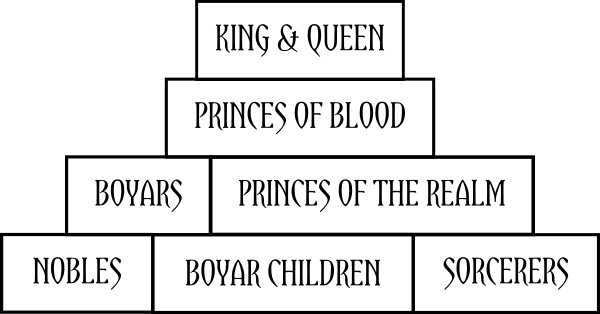Social Structure of Bereg - Upper Classes
This article describes the Bereghin Realm in 1681 Asunder.
The upper classes of Bereg can be roughly visualized as a pyramid that looks thusly:
King & Queen
Form of address: my king/queen, my liege, sire/mother The reigning monarch of Bereg are called a king or a queen. The position is passed through absolute primogeniture - the eldest child of the previous monarch inherits. The source of a monarch's authority (and the biggest legitimizing mechanism for the entire social structure) is the so-called Fate's Decree - the idea that things are the way they are because Fate willed it that way and so it's only natural. The power of the monarchs has been growing more and more centralized over the centuries, however, by 1680s the boyars and the princes still wield enough influence that the monarchy can't be called absolute.Boyars
Form of address: bann/bana The boyars are aristocratic families who own their lands rather than hold them as fief from an overlord. What ties them to the monarch (and the rest of the realm) is a personal oath of allegiance, which must be renewed whenever the head of the house or the monarch changes. Because of this, the boyars enjoy many freedoms and privileges—among them the freedom to practice battle magic as they see fit. There are eight boyar families in Bereg, all named after a bird: Swan, Eagle, Raven, Crane, Hawk, Dove, Owl, and Nightingale. The first of these – the Swan sigil – is actually the royal family, but, since the Bereghin monarchs started out as the first among equals, they are a sort of honorary boyars. The monarchs also intermarry with the boyars a lot, as a tactic to ensure their loyalty. The boyars are also unique in that, unlike the royal family and the rest of Bereg, their succession is determined by the ancient rota system, where it's not the child that inherits, but the most senior living blood relative. Yes, things get awkwardly complicated. That's why the monarchs switched to the absolute primogeniture a couple of centuries ago.Princes
Forms of address: sire/mother, prince/princess (sometimes also my prince/my princess) The Bereghin princes come in two flavours:- princes of blood, aka the blood relatives of the reigning monarch;
- princes of the realm—hereditary rulers of large Bereghin provinces. The difference between them and the boyars is that the princes hold their principalities as fiefs, and the monarch, in theory, is allowed to take those lands back, whereas the boyars own theirs.
Nobles
Form of address: bann/bana The Bereghin nobility has its roots as "people of service" - administrators, advisors and soldiers who served one of the major landowners and were rewarded with land. The overwhelming majority of them still holds their lands as fiefs from either the boyars, the princes, or the crown directly. The nobles of Bereg are all legally equal, and take pride in it, though in practice their status does vary somewhat depending on wealth and on how much land they have. These last two are not directly related - many nobles make a decent living as administrators, courtiers, judges, and so on. It is also the nobles that constitute most of the officer corps in the Bereghin army.Boyar Children
Form of address: bann/bana The boyar children are Bereghin sorcerers licensed to practice battle magic. As the name suggests, this task was originally limited to the boyar offspring. However, in the recent centuries, Bereg has been extremely short of battle mages, for two reasons:- Killing/violence is culturally perceived as rather abhorrent throughout Halqueme, and turning the naturally life-affirming force of magic towards war has been historically perceived as... well, obscene. The Boyars, while acknowledging the power of battle magic and refusing to cede their monopoly on it, were never very keen to actually practice it.
- Magicians, no matter what specialty, train from as early an age as possible in order to achieve full potential. Once trained, they must not have children, because the mageborn tend to turn out... wrong. Which means that the boyars who practice battle magic can't continue the dynasty. Since boyar families have 2-3 children on average, they are often very reluctant to lose the spare heir.
Sorcerers
Form of address: bann/bana The Bereghin sorcerers are magicians who practice magic other than battle magic. These are the healers, the artefactors, the seers, the alchemists, and so on. They are a social class separate from everybody else, including their birth families (at least, in theory), and they are roughly equal to the nobles in standing. While some sorcerers do come from noble background, the majority of them are children of well-to-do commoners, such as merchants or artisans. Sorcerers generally begin training between ages of 10 to 12 and most of them begin independent practice in their late teens, though some focus on academic research instead and continue studying well into their twenties.
Parent Organization
Remove these ads. Join the Worldbuilders Guild




Comments